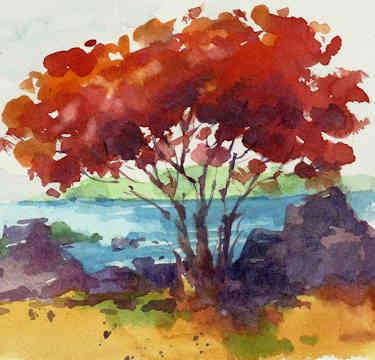The Utterly Intimidating First
Brush Stroke.

Applying that first brush stroke of paint to a pristine white surface can be almost paralyzing.
And the larger that surface is, the scarier it can be.
At least that's how it was for me years ago when I first began playing with watercolor.
I would mix and mix and mix, trying to get the perfect color and the perfect value before I dared apply it to the paper.
I was deathly afraid of that first dab of color. Afraid it would be way too intense and way too dark.
Just totally ruin the art.
So, naturally, after the first brush stroke dried, it looked much too weak and much too light.
That brought instant panic.
Overcoming The First Brush Stroke Panic
What should I do? I'd groan. How could I even attempt to continue after this totally botched first brush stroke?
Maybe I should just start over.
Or maybe I should continue painting and see what happened. I mean I'd already ruined it. What more did I have to lose?

Any of this sound familiar?
Eventually, after suffering frayed nerves enough times, I realized I was worrying much too much.
It gradually became obvious that by the time each watercolor was done no one would even see that first brush stroke.
Besides, even if it wasn't the perfect color and value, I could adjust as I painted.
Have A Plan: Know What You Want to Do
In those early days, I could have saved myself a lot of stress by simply doing better planning and testing before starting to paint.
By planning I'm talking about doing preliminary sketches to figure out a good design and where the star of my picture would be.
It also helps to decide whether the painting will be mostly warm in tone or mostly cool colors.
A color scheme often works much better when there is one dominant tone. That should be decided in the beginning.
As part of the planning process I sometimes take a separate piece of the material I am going to paint on and test the colors I want to use.
It helps to see the colors next to each to determine if they will work together.
I adopted this method after reading how Georgia Okeefe did this before and as she painted.
What this initial planning and testing does is create confidence.
You gain confidence that the painting, from first brush stroke to last, will succeed. It gives you a clearer idea of what you want to do.
Joseph Zbukvic, noted Australian watercolorist, mentions in one of his videos that confidence, having a picture in your mind's eye of what you want to accomplish, is key to success.
What would help instill that kind of confident picture in your mind?
Best Wishes,
Gary Gumble
Founder of BeginningArtist.com
Without art the crudeness of reality would make the world unbearable. (George Bernard Shaw)
P.S. Part of learning to be an artist is getting instruction that fills in the blanks in your knowledge. The kinds of things that are hard to acquire on your own.
That helps you improve both your skills and your confidence.
The other part of becoming an artist is getting to know yourself better.
Discovering your strengths, as well as your weaknesses.
Admitting the things that scare you.
And learning how to overcome them.
So that first brush stroke never intimidates you again.
More on this later.
Copyright Gary Gumble 2023 All rights reserved About Privacy Policy Terms of Use Contact www.beginningartist.com 27 rue Roucher, 34000 Montpellier, France